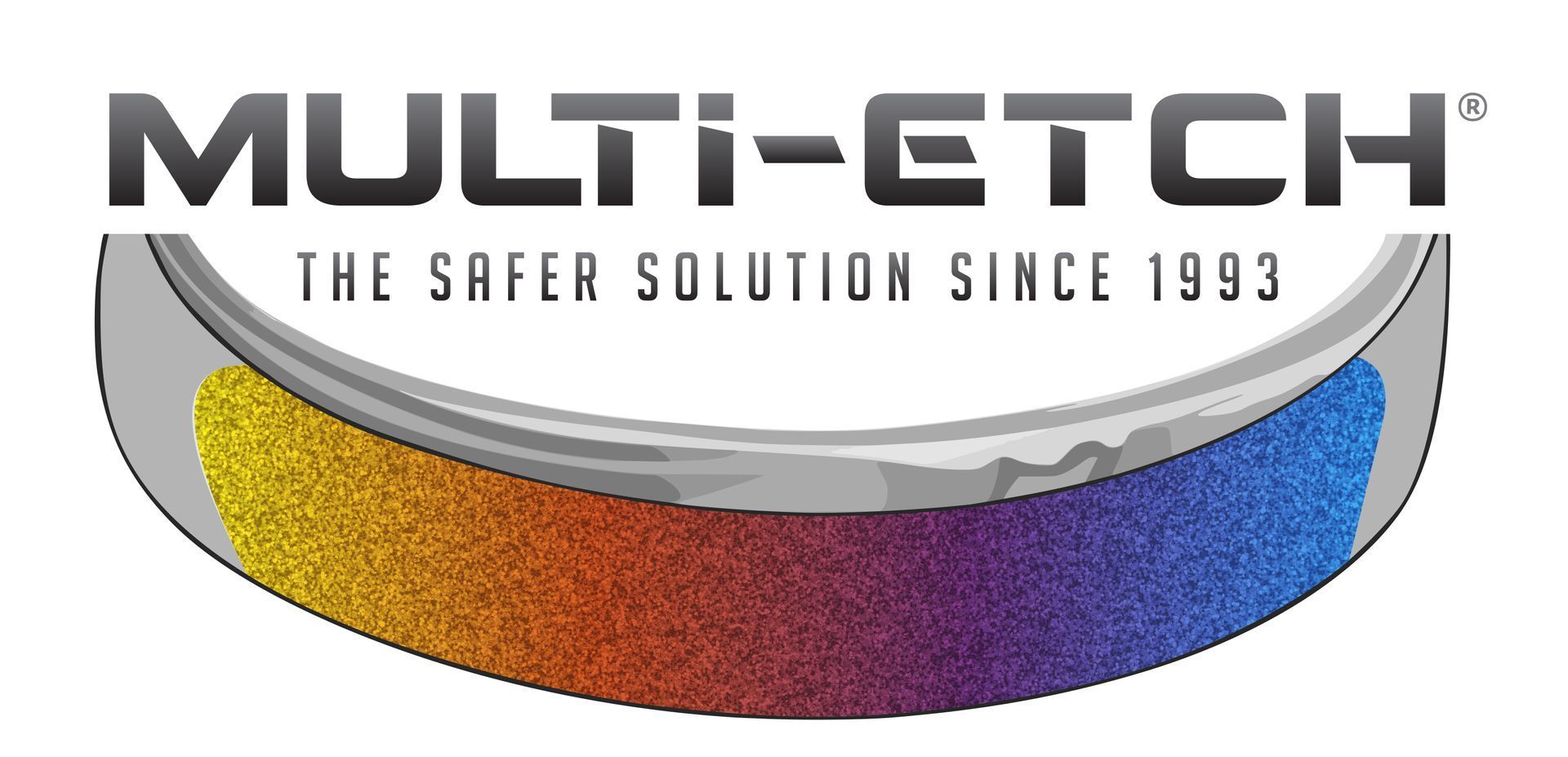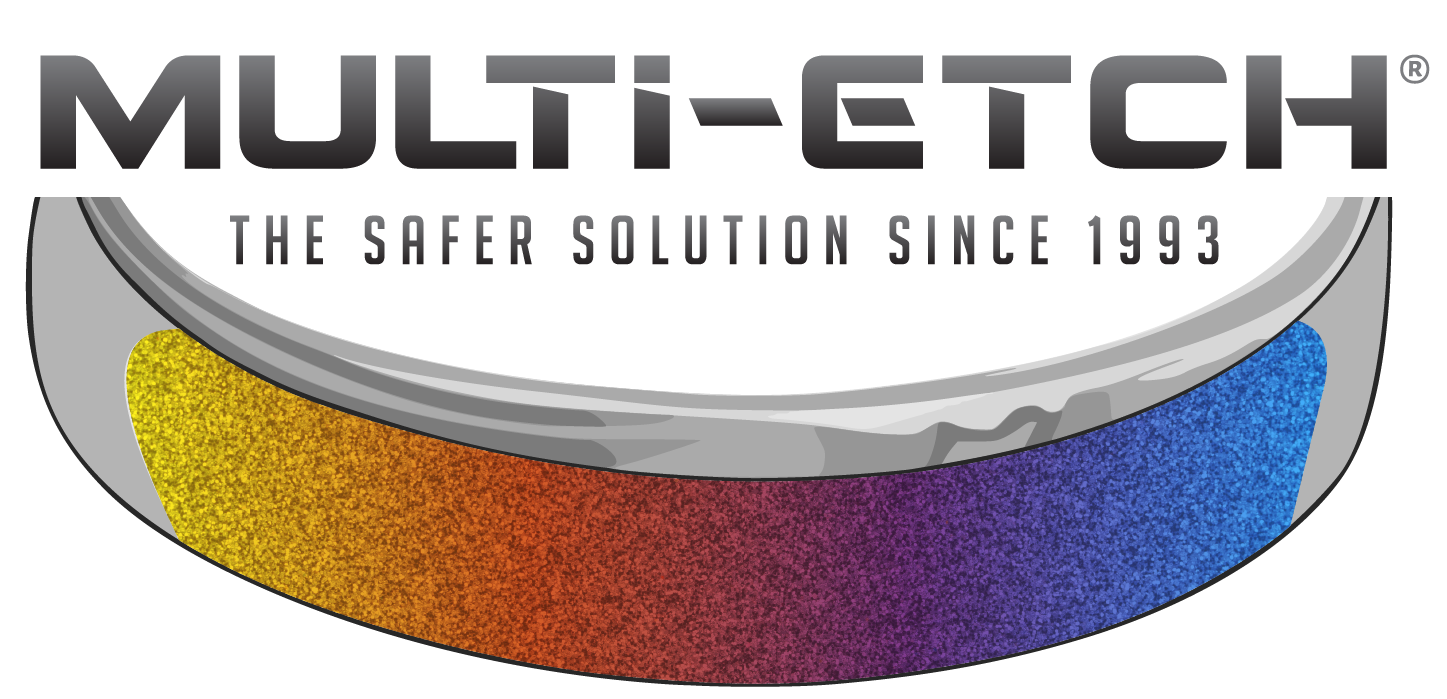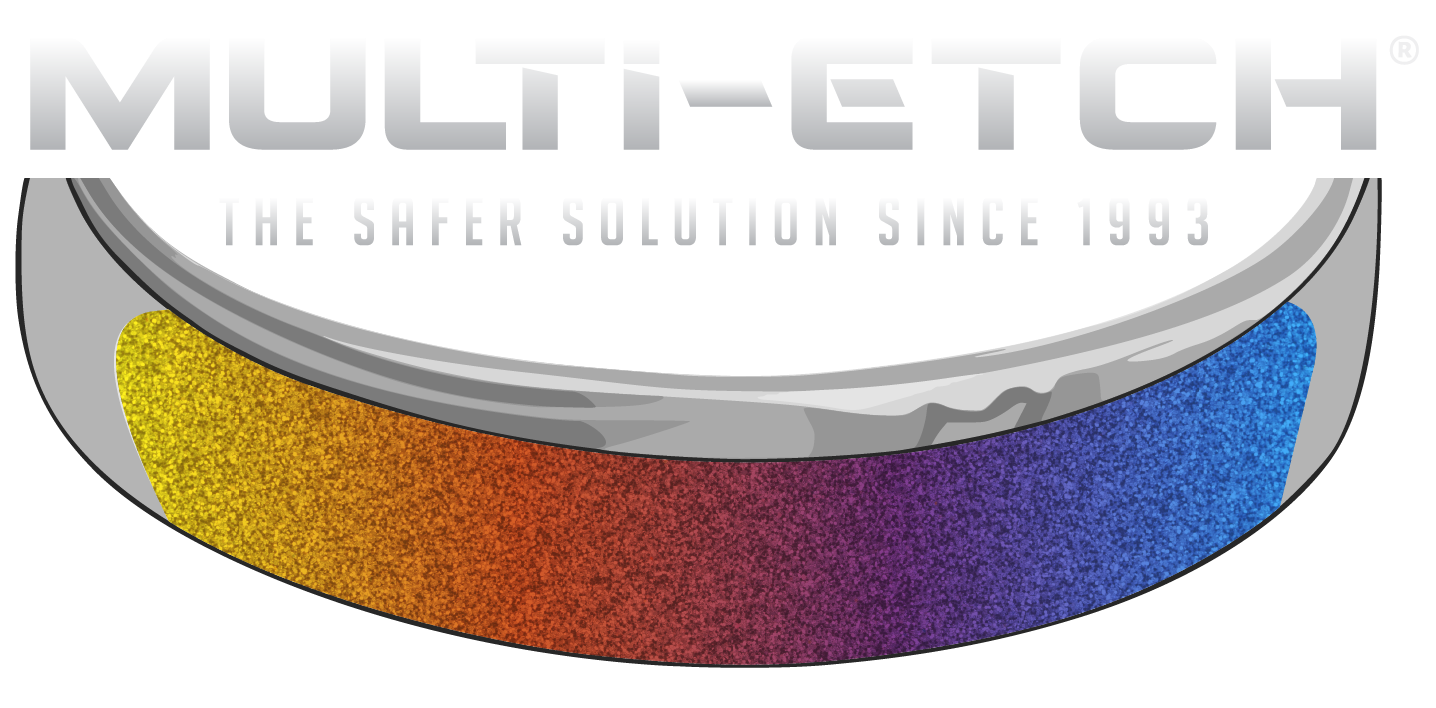ETCHING TITANIUM WITH
MULTI-ETCH
How to etch titanium with
Multi-Etch, the safer alternative to hydrofluoric acid
Multi-Etch was originally developed for use on titanium, and is a perfect low acid (pH 6.8) alternative to hazardous hydrofluoric (HF) acid
Multi-Etch was originally developed for use on titanium, and is a perfect low acid (pH 6.8) alternative to hazardous hydrofluoric (HF) acid
How much titanium will one gallon of Multi-Etch etch? Approximately 5,000 square inches of titanium when dipped for seven to ten seconds at 150–160°F. As you etch, the etchant gradually becomes ineffective and saturated with titanium ions that can re-plate to the metal, causing uneven anodizing.
Etch times shown in the charts below are guidelines. Etch times can vary depending on the freshness of the etch bath.
Surface finish — whether polished, matte, etc. — will be maintained as long as the etch time is less than 20 seconds. Longer etch times will tend to change polished finishes to matte. After 5 minutes, the finish starts to trend to semi-polished.
Titanium with mill oxides, which are hard to see, may require longer etching times. For many small parts, use a tumbler with ceramic media moistened with double strength Multi-Etch; tumble for approximately 15 minutes.
Preparing titanium for anodizing or welding using Multi‑Etch
| GRADE | PROCESS | ETCH TIME | SURFACE CHANGE |
|---|---|---|---|
| All grades |
|||
| 150–160°F regular strength |
7-10 seconds |
Brightens |
|
| 70°F double strength |
2 minutes |
Brightens |
Removing color from titanium using Multi‑Etch
Note: Times are for removing high-voltage green; lower voltage colors will take less time to remove.
| GRADE | PROCESS | ETCH TIME | SURFACE CHANGE |
|---|---|---|---|
| 1 (CP) |
|||
| 150–160°F regular strength |
30 seconds |
Brightens/matte |
|
| 150–160°F double strength |
30 seconds |
Brightens/matte |
|
| 70°F double strength |
6 minutes |
Brightens/matte |
|
| 2 (CP) |
|||
| 150–160°F regular strength |
2 minutes |
Brightens/matte |
|
| 150–160°F double strength |
75 seconds |
Brightens/matte |
|
| 70°F double strength |
24 minutes |
Brightens/matte |
|
| 4 (CP) |
|||
| 150–160°F regular strength |
50 seconds |
Brightens/matte |
|
| 150–160°F double strength |
40 seconds |
Brightens/matte |
|
| 70°F double strength |
8 minutes |
Brightens/matte |
|
| 5 (6/4 aircraft grade) |
|||
| 150–160°F regular strength |
1 minute 40 seconds |
Brightens/matte |
|
| 150–160°F double strength |
1 minute |
Brightens/matte |
|
| 70°F double strength |
40 minutes |
Brightens/matte |
Etch rates for titanium using Multi‑Etch
| GRADE | PROCESS | ETCH TIME (minutes) | ETCH DEPTH (inches, cumulative total)) | SURFACE CHANGE |
|---|---|---|---|---|
| 1(CP) |
||||
| 150–160°F regular strength |
1 |
0.00012 |
Brightens/matte |
|
| 2 |
0.00023 |
Brightens/matte |
||
| 3 |
0.0004 |
Brightens/matte |
||
| 150–160°F double strength |
1 |
0.00023 |
Brightens/matte |
|
| 2 |
0.0006 |
Brightens/matte |
||
| 3 |
0.0008 |
Brightens/matte |
||
| 2(CP) |
||||
| 150–160°F regular strength |
1 |
0.00016 |
Brightens/matte |
|
| 2 |
0.00036 |
Brightens/matte |
||
| 3 |
0.00046 |
Brightens/matte |
||
| 150–160°F double strength |
1 |
0.00045 |
Brightens/matte |
|
| 2 |
0.00092 |
Brightens/matte |
||
| 3 |
0.00115 |
Brightens/matte |
||
| 4(CP) |
||||
| 150–160°F regular strength |
1 |
0.00015 |
Brightens/matte |
|
| 2 |
0.0003 |
Brightens/matte |
||
| 3 |
0.00035 |
Brightens/matte |
||
| 5 (6/4 aircraft grade) |
||||
| 150–160°F double strength |
1 |
no change |
Brightens/matte |
|
| 2 |
0.000084 |
Brightens/matte |
||
| 3 |
0.00022 |
Brightens/matte |
||
| 4 |
0.00043 |
Brightens/matte |
Step-by-step guides on etching with Multi-Etch
The guides below demonstrate etching with titanium, but the order of steps are the same for etching any metal.



